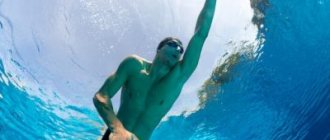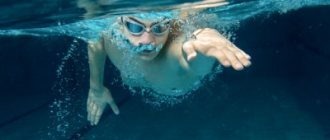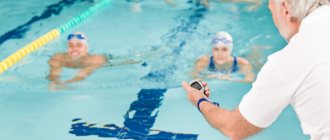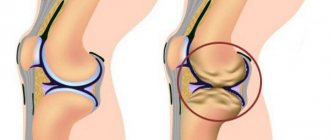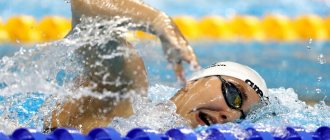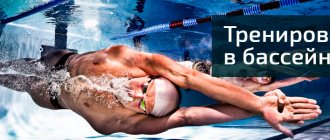In this article we will tell you how to learn to swim from scratch, on your own and without the help of a coach. Even if you are an absolute beginner, you are afraid of water, you don’t know how to dive or even stay afloat. Do you think this is impossible? Whatever the case!
Despite all the apparent complexity, learning to swim on your own is not at all difficult for an adult. Here are the stages he will have to go through:
- Overcome the fear of water;
- Learn to lie on the surface on your stomach and back;
- Learn safety precautions and rules of behavior in the pool;
- Study basic swimming techniques in theory and practice;
- Maintain strict discipline, find an unshakable source of motivation, tune in to the result and go towards it no matter what.
Where to study?
The pool is the optimal place to start training.
Village methods a la “put in a boat, swam out to the middle of the lake, threw into the pond - swim” are absolutely unacceptable. There may be no result, but there may be mental trauma.
For training, it is better to choose a shallow pond in which you can stand so that your head and shoulders are above the water. This creates a feeling of security for the beginner; he is less worried about drowning.
A natural body of water - a river, a pond, a lake - can serve this purpose, but the best option for an adult is a swimming pool . For the very basics, the outermost paths are usually selected, where there is a side, which is very helpful in the initial stages of learning.
“Sports swimming. The path to success”, E. U. Maglisho, V. N. Platonov
Two books in this publication contain a system of knowledge about the methods of training swimmers at all stages of their sports career: from schoolchildren to highly qualified athletes. This monumental work is addressed to coaches, scientists, sports doctors and, in fact, the swimmers themselves.
General principles: gliding, breathing, position on the water
Swimming has its own three pillars on which it rests: body position, proper breathing and gliding. Below we will dwell in more detail on each of them.
For beginners, the first thing that is important is staying on the water: you need to learn how to lie on the water on your own and not drown.
To do this, you need to relax, lie horizontally and straighten up. Try to feel the water. The feeling of water is one of the most important things you need in swimming. Do not inhale water through your nose and mouth, and also do not twitch - if you twitch, your body seems to group, the center of gravity shifts and you begin to sink.
In order to learn how to float on the surface of the water, start with the following exercises.
J.M. Barrie Amateur Swimming Society, Barbara Zitwer
If you want to read something from fiction, but related to your favorite swimming, Barbara Zitwer's book is for you.
This work tells the story of an American woman, Joy, who finds herself in the English province in winter, where the famous author of “Peter Pan” J. M. Barrie loved to visit. Joy is jogging along the pond and suddenly notices a drowning man in it. She immediately rushes to help, but it turns out that the rescued elderly lady does not need help at all: she swims in the pond every day, in any weather, at any time of the year.
The English lady has four friends who call their team a society of swimming lovers, and now our heroine, a career-obsessed American, joins them.
Exercises for staying on the water
Star
- Standing in waist-deep water, raise your arms forward and up.
- Then, taking a deep breath, slowly stretch forward, plunging your face into the water.
- At the same time, spread your legs and arms to the sides, like a starfish.
This way the body weight is evenly distributed. Then perform similar actions on your back.
This video explains how to make a star:
Float
- Stand in chest-deep water.
- Take a deep breath.
- Sit down under the water, at the same time press your chin to your chest and clasp your knees with your hands. Your body will float up and stay on the surface.
As long as you maintain this position, you are floating on the water - as shown in this video:
Scheme for performing this exercise:
Threshing
- Grasp the side of the pool, river pier or other support with your hands.
- Stretch back and begin to work with your legs , while keeping your legs straight and your toes extended.
It is very important not to splash with all your might - this reduces the effectiveness of the exercise, but to create a turbulence in the water, like the motor of a boat.
A similar exercise can be done in motion - with a swimming board:
Frog legs
- Grasp the support with your hands, as in the previous exercise. However, the legs should be slightly apart and bent at the knees, and the ankle should be turned 90 degrees.
- Imitate the movements of a frog: push off from the water, straightening your legs, then press them back to their original position.
Thus, you will catch two birds with one stone: you will learn the basics of breaststroke technique, and also learn how to stay on the water.
Correct breathing. Principle and exercises
The main principle of breathing is to inhale through your mouth, then exhale into the water through your nose or mouth (it’s better to practice exhaling through your nose first).
In competitive swimming, a sharp inhalation is practiced, but if you are a beginner swimmer, the deeper and stronger you inhale, the better you will stay on the water - like a fish’s swim bladder (you can also read our article about holding your breath).
Exercises designed to build correct breathing technique:
- Exhale into the water: holding the side with your hands, inhale through your mouth, then exhale into the water through your nose:
I take a breath
Exhale - In an open body of water, instead of holding on to the side, you can squat and exhale into the water:
- Subsequently, you can complicate the task by combining the practice of two “whales”: Hold your hands on the side, inhale and exhale according to the exercise above, while simultaneously working with your legs - “frog” or “threshing”.
Sliding on the water
Gliding is the next step in mastering swimming techniques , because... it underlies all four styles. Therefore, it is necessary to master it yourself both from a stationary state and in motion.
Sliding after the float
- Assume the pose from the Float exercise.
- Then push off the side with your feet, take a horizontal position and slowly slide by inertia through the water , counting to yourself to 10.
- The face should be in the water, and the head should be straight, continuing the line of the spine.
Repeat this exercise until you get it right!
There is also an alternative option: pushing from the bottom of the pool.
Sliding in the pool with a push from the side
Sliding in an open body of water with a push from the bottom
Sliding after a push
- Push off the bottom or side with your arms extended forward.
- Then move as if you were raking water with straight arms and palms facing out.
- Then gather them under your chest again and bring them forward together.
- Repeat these movements slowly but powerfully, do not allow fuss - it will only harm efficiency.
Don't Breathe, Diana Nayyad
This is the exciting story of a swimmer who was the first in history to swim across the Straits of Florida. In this most dangerous corner of the planet there are over 40 species of sharks, more than a hundred poisonous jellyfish, it seems that nature itself is against humans appearing here.
Trained athletes have been making unsuccessful attempts to swim across the strait for more than 60 years, and only in 2014, 64-year-old Diana Nayyad conquered these 170 km of water “Everest”.
Overview of swimming styles
In modern methods of teaching swimming, there are four official styles :
- breaststroke,
- crawl (on the chest),
- back crawl,
- butterfly (dolphin).
Breaststroke is otherwise called “frog swimming.” It consists in the fact that the legs and arms make synchronous movements - the legs push off from the water “like a frog”, the arms seem to rake the water. Read about learning this style at this link.
Breaststroke pattern
The crawl consists of alternately moving the arms and legs. The arms replace each other cyclically, and the legs create a seething, serving as a “motor.” The teaching method for this style is here.
back crawl technique is very similar to the above style, the main difference being the inverted position of the body: the face looks up, the arms move up and back, plunging into the water at the ear, and the body turns slightly following the movement of the arms.
Crawl swimming pattern
Butterfly (dolphin) is traditionally considered one of the most difficult styles. It consists in the fact that the legs make smooth wave-like movements, like a mermaid’s tail; hands simultaneously sweep forward, above the water, then plunge into the water.
Butterfly swimming pattern
“The art of training a swimmer. Coach's book", V. B. Avdienko, I. N. Solopov
An athlete can do without literature on swimming, but a coach cannot. The presented manual summarizes the practical experience of training a number of world-class swimmers, and the book can become a reference book for practicing specialists.
The publication, moreover, is quite recent: the work was published in 2019 and contains modern preparation methods.
What swimming style should I start with?
Once you have learned how to float and glide through the water, the next step is choosing the style in which you will swim.
Here, crawl is most often recommended for beginners , although some people prefer breaststroke. People don’t start learning swimming from butterfly, since it is the most difficult (at least physically) style.
The following speaks in favor of learning to swim crawl first: the technique of this style is considered easier than the breaststroke technique - both in the work of the arms and in the work of the legs.
For beginners, the simpler the style, the better, so try starting with the crawl.
To start swimming crawl, work your legs in the water, as in the “threshing” exercise, while alternately moving your arms, describing circles around the shoulder joint. Their movements should be uniform in speed - while one hand is making a stroke, the other is sweeping over the water. As you do this, reach for your dominant hand. The body waddles a little, turn your head towards the lowered hand and inhale, then exhale into the water.
If you want to learn this style more well and correctly, you need to read our separate article about the crawl technique and a separate article about teaching this style.
Butterfly
Butterfly is a type of swimming in which all parts of the body move simultaneously. Because the legs are closed and their movements resemble those of a fish's tail, this technique is also called dolphin swimming. This style is considered the most energy-intensive.
Butterfly swimming technique
When swimming butterfly, the body constantly moves up and down: when the shoulder girdle lowers for the stroke, the lower back rises. And as the shoulders rise, the lower back sinks under the water. The technique is quite complex, so it is better to master it with a trainer.
Here are the basic rules:
- Extend your arms forward with your fingers closed. Then spread your arms out to the sides, keeping your elbows higher than your forearms. A stroke will occur, the body will rise above the water. At this moment you need to inhale.
- Bring your hands closer to your pelvis, then lift them above the water and quickly move them forward for the next stroke.
- Push with your legs closed, slightly bending your knees.
- For each stroke there are 4 kicks - down-up, down-up. The first two movements raise the head and shoulders, the second - the lower back.
The swimmer periodically lifts his chest out of the water to inhale. At the same time, breathing should also be rhythmic.
Exercises on dry land
Exercises to better understand leg movements:
- Stand with your back to the wall on one leg. Pull the second one forward slightly.
- Squat down, bending your supporting leg at the knee.
- Straighten your supporting leg and tilt your pelvis back.
- Take your other leg back and move your pelvis forward.
The legs move underwater during swimming using the same principle.
Exercise to practice body movements:
- Stand with your back to the wall at a distance of 20 cm.
- Bend over so that your shoulder blades touch the wall.
- Round your spine and “roll” it along the wall from your neck to your lower back.
- Touching the wall with your buttocks, straighten up and then bend at the waist.
Such a wave will help you understand how the body should move from the chest to the tailbone.
Exercises in water
To teach wave-like movements, you can do the following exercise:
- Take air into your lungs and lie down with your chest on the water. Keep your head straight, look down, relax your neck, stretch your arms in front of you.
- Make a stroke, describe a semicircle with your arms and press them to your body. Then bend your elbows slightly.
- Make a wave with your body from head to toe and at this moment return your arms to their original position, moving them forward above the water.
Advantages and disadvantages of the butterfly style
This is a very beautiful type of swimming, but the technique is difficult to learn and perfect on your own. But the instructor can explain everything quickly enough.
How to learn to swim like a dog
We have a separate article devoted to doggy swimming, its features and expediency. We recommend that you familiarize yourself with it; below is a brief summary of it.
For those who are too early to move on to learning the front crawl, there is a fifth, unofficial style - “swimming like a dog.”
This is an unsportsmanlike style and, in general, it is not very beneficial for the body (the neck is overstrained). However, if you don’t see it in yourself to master one of the “correct” styles, then you can first learn to swim at least “doggy style”:
- Keep your arms slightly bent in front of you underwater.
- The head should be above the water and the legs should be behind, with the knees slightly bent.
- Alternately make movements with your limbs: with your arms, rowing under yourself, with your legs, kicking under water.
- Avoid fuss - everything should proceed calmly and slowly, concentrate on technique.
Doggy style swimming pattern
Fear of water
There is no need to be afraid of water!
All efforts can go to waste if there is a fear of water. When a person finds himself in water, he is paralyzed by the fear of drowning and cannot do any exercise.
The main advice for overcoming fear is to trust the water. Relax and have fun .
Concentrate all your attention on the exercise, on improving the technique. It's like with a bicycle: while you pedal, your balance is maintained.
General recommendations for visiting the pool
- Proper swimming necessarily involves immersing your head in the water, therefore, regardless of the chosen place, you need to have a swimming cap (to prevent hair from getting in the way and to protect the hair roots) and goggles (to protect the eyes from exposure to water, as well as improve visibility in the water column).
- Eat right. It is ideal to eat no later than 40-60 minutes before training , and afterward, have a hearty meal an hour and a half later, but you can and should keep some fruit or dried fruit with you - after exercise, a strong feeling of hunger is absolutely normal.
If you work out in the morning, your ideal breakfast would be coffee, a muesli bar, and a banana. Carbohydrates will quickly burn during training, and you will not gain weight. - The optimal time for training is in the morning . According to research, it is during these hours that the result is most productive, and the release of endorphins into the blood will provide you with a good mood for the rest of the day. Moreover, the pool is usually not crowded in the morning, which provides additional mental comfort.
- Remove jewelry before class. Usually this, like wearing a hat, is spelled out in the rules. The reason is simple: all kinds of rings and earrings can easily fall into the water and get lost.
- Warm shower and warm-up . In the first case, hot water performs two tasks: cleansing the body of dust and germs, and warming up warms up the muscles, which guarantees an excellent workout result. Don't forget to shower after your workout! You will wash away the chlorine from your body and also relax strained muscles. Also rinse your swimsuit - it will last longer.
- Wearing rubber slippers in the pool area.
Despite the presence of rubber mats, it is very easy to slip on wet tiles and get injured. In addition, walking without slippers increases the risk of fungal infections.
Training program: advanced level
An advanced pool training program is more suitable for men than for women when considering amateur athletes.
The program is aimed at developing physical fitness and improving swimming technique:
Warm-up : 2x100 meters freestyle, focusing on the arm stroke. Rest between sets – up to 1 minute.
Main distance : we walk 2x200 meters freestyle. We perform the first approach at a moderate pace, the second at a high pace. Rest between sets – up to 2 minutes.
Swimming on legs : 6x25 meters. You can use fins. The pace is high. The break between approaches is up to 30 seconds.
Next we perform a cardio complex:
- We walk 400 meters in any style at a moderate speed without stopping. The rest time between exercises is minimal.
- We cover the distance with our feet using a board: 200 meters, moderate speed without stopping.
- 200 meter strokes. The first 100 meters - inhaling on every 3rd stroke, the second half of the distance - on every 5th stroke. To perform this, “scapulas” are used.
Cool down: 100m freestyle, slow.
The number of meters covered can be reduced, but the total distance must be at least 1200 meters.
What are the benefits of exercising?
Swimming strengthens the spine
Swimming is not only pleasant, but also useful because:
- The respiratory system develops. During training, a swimmer breathes deeply and frequently, because... This sport requires a colossal amount of oxygen, therefore, the volume of the lungs with regular training increases significantly.
Outwardly, this is manifested by a beautiful wide chest, which can be an additional incentive for men.Good news for those who are trying to get rid of cigarettes: exercise in the pool helps reduce the craving for smoking and cleanse the lungs of accumulated harmful substances.
- The cardiovascular system is strengthened .
During swims, the pulse increases due to the fact that oxygen must be distributed to all cells of the body. The heart and blood vessels have to push a large amount of oxygen-enriched blood through themselves, so in the process the heart muscle and vessel walls are pumped: they become stronger. The heart rate also decreases, which reduces the risk of developing cardiovascular diseases. - Strengthening muscles .
It's no secret that during training all muscle groups are involved. As a result, the overall endurance of the body increases and a beautiful body is modeled. Swimming has a particularly beneficial effect on the back muscles: they become stronger, and your posture is straighter - in 2-3 months, if you visit the swimming pool regularly (2-3 times a week), moderate curvatures can be corrected. - Nervous system. In the medical histories of modern city dwellers one can often see diagnoses such as neurasthenia, hysteria, and psychasthenia. Water, coupled with physical activity, perfectly helps to recover from these diseases. During the swim, the nerve endings are gently massaged with water, resulting in relaxation and calming.
Also, after a thirty-minute session, the pleasure hormone endorphin is released into the blood, which also increases stress resistance.In addition, it is believed that water is a calming factor for humans, because... being in it subconsciously reminds him of the time when he was in the womb, where it was quiet, cozy and calm.
- Immunity . The water in the pool is quite cool, which promotes hardening. This, in turn, increases resistance to colds.
- Stimulation of metabolic processes .
Anyone who wants to lose weight is advised to sign up for a swimming pool. This is no coincidence: swimming is a rather energy-consuming, aerobic sport. Remember from your school biology course: oxygen is one of the main components in the energy metabolism that occurs in the mitochondria of cells. Fats and carbohydrates, the body’s “fuel,” are broken down, metabolism accelerates, and you lose weight! It's simple.
Is it real...?
“It’s never too late to learn” - this expression is heard very often when a person begins to master, by the way, foreign languages or the art of ceramics.
However, is it possible to learn to swim as an adult if for some reason you missed this opportunity earlier? Can changing body characteristics interfere with learning, as in gymnastics and ballet?
Correct answer: yes. You can start swimming at any age , the main thing is to put aside fears and doubts, and also set the right goal. This is where the main catch of the expression “I want to learn to swim” lies - for some it is quite enough to stay on the water and not drown, but for others they are ready to improve their technique by correcting the mistakes made when swimming in order to swim like Michael Phelps - technically correct , beautiful, powerful and fast.
Ideally, all swimmers should strive to master all four strokes, but above all, they need to motivate themselves. Without this, the matter will not move forward, so you need to create the right motivation for yourself.
Memo
- The best way to learn to swim is to practice constantly.
- The fastest way to learn to swim is to use the services of a coach.
- If you are afraid of water, use a circle, a board and other accessories until the fear passes.
- After training, dry the inside of your ears well to avoid developing otitis externa - “swimmer’s ear.”
- Swimming strengthens the muscles of the whole body, so at first they will hurt. To reduce pain, you can combine swimming training with stretching.
